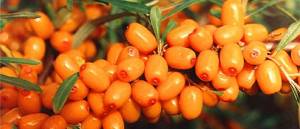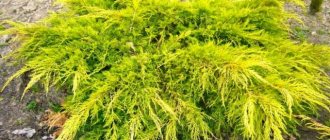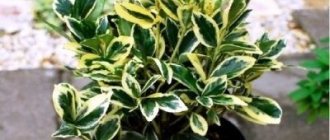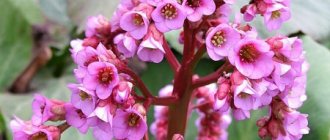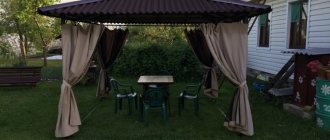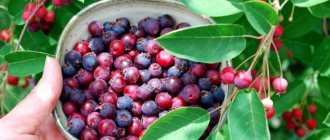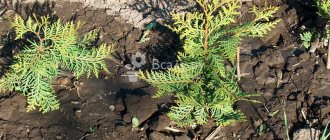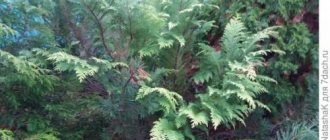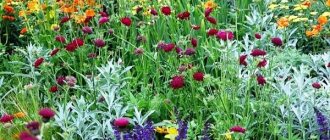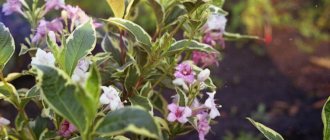The sweetest varieties
Wild sea buckthorn is slightly sour and bitter. However, breeders have bred fruit trees and shrubs with sweet, aromatic berries. They are classified as dessert; there are options for all regions, including Siberia and the Moscow region. Such fruits are valued as medicine and delicacy.
Darling
For sea buckthorn Lyubimaya, the description of the variety always includes an indication that the bushes are low and there are almost no thorns. By September, 7 kg are removed from each bush. The fruits are large (up to 0.7 g), slightly elongated, fiery orange. The inside is loose, which is considered a plus when preparing for the winter or obtaining oil. Winter-hardy, endowed with immunity against most diseases.
Roots
When describing the variety of sea buckthorn Ruet, attention is focused on the thorns. They are short, and only on the top of the branch. The berries are bright orange, weighing up to 0.65 g. They have a rich sweet and sour taste and a pleasant aroma. More advantages: small height, compact crown, 12-14 kg of fruit per tree. The variety is early ripening, winter-hardy, the harvest ripens even in Siberia or the Moscow region. But it requires planting in a sunny place, annual preventive pruning, and regular fertilization. An abundance of moisture is not necessary.
Tenga
Precocious appearance. Sea buckthorn is large (0.75 - 0.8 g), with a rich taste and fresh aroma. Ripeness is indicated by the orangeness of the peel with ruddy color. One plant produces 12-14 kg of harvest.
The height is average, there are few thorns. “Indifferent” to sea buckthorn mites and flies.
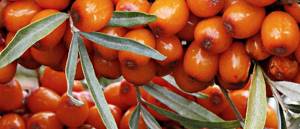
Muscovite
Sea buckthorn Moskvichka has the following variety description. A low tree with a pyramidal crown and few thorns. The peel is thin, bright orange with reddish spots. The pulp is dense, the harvest (8-10 kg) can be stored and transported. The tree is resistant to frost and disease. Mid-season variety, ripening by the first ten days of September.

Nizhny Novgorod sweet
The main advantage of the variety is its large sweet fruits (almost 1 g). They appear for the second or third season by the end of August. The bush grows quickly, is not particularly tall, but spreading. Produces up to 10 kg of sea buckthorn per season, loves the sun. The fruits resemble orange-yellow cylinders and are easily separated from the stalk.
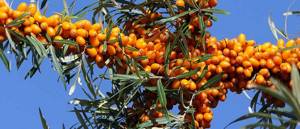
Claudia
A bush of medium height with a round, spreading crown and sparse, thin thorns. The first harvest appears by the fourth season, 9-11 kg per bush. The berries are large (up to 0.8 g), bright orange, sweet cylinders that are easy to pick. Versatile in terms of processing. A good option for transportation or freezing. Sea buckthorn Claudia is not afraid of cold weather, viruses, and sea buckthorn flies.

Sea buckthorn varieties without thorns
Thorns are the main obstacle for those who want to grow sea buckthorn. To eliminate it, breeders developed sea buckthorn varieties without thorns or with minimal density and dimensions.
Solar
A thornless tree-like shrub up to three meters in height with a luxurious crown. It bears fruit from the third season and is considered mid-season and winter-hardy. The amber peel covers the sweet and sour pulp. The standard fruit weight is 0.7 g, one bush produces 9-10 kg. Endowed with good immunity to pests and diseases.
Socratic
A powerful tree-like shrub taller than three meters with a spreading crown. Produces 9-10 kg of berries (0.6-0.8 g), which ripen by the end of August. Due to the absence of spikes, they can be assembled without problems. Reddish-orange sea buckthorn is recognized as one of the most delicious. Good disease resistance.
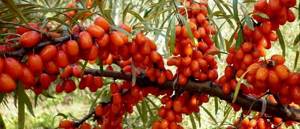
Zhivko
Thornless bush of medium height with an oval crown. The harvest is abundant - 14-20 kg, ripens late. The orange-red, oval berries come off without damaging the skin (“dry pull”). But they are too small - 0.5-0.6 g, and not particularly tasty. However, with a higher oil content.
Giant
For the Giant sea buckthorn, the description seems contradictory. The bush is not tall, produces a maximum of 10 kg of fruit. But the berries are truly gigantic, up to a gram each. Specimens of one and a half grams are not uncommon. They have a cylindrical shape and are orange in color. They appear by mid-September, in the third or fourth season. Pros: absence of thorns and “dry” tearing. In the Moscow region and other regions with short or cool summers, it may not ripen.
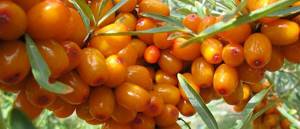
Girlfriend
Sea buckthorn Podruga combines two important qualities: the absence of thorns and frost resistance. A mid-season variety is a good option for Siberia, the Moscow region and similar regions with frosts down to -40°C.
The orange, slightly elongated berries are massive - 0.8-1.1 g, and leave a refreshing aftertaste. My friend is “indifferent” to most diseases.
Altai
The main difference between sea buckthorn of the Altai variety is its sweet pulp, which exudes the aroma of pineapple. Other advantages:
- The shrub is compact, suitable even for a small area.
- Fruits generously, 14-16 kg.
- The berries are large, up to 0.85 g. They come off easily.
- The crop is harvested without problems, since there are no thorns.
- Frost resistance up to – 45°C.
Sea buckthorn ripens, becoming bright orange by the end of summer. The plant is hardy and almost never gets sick.
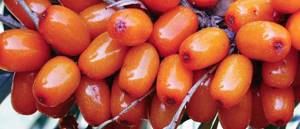
Chechek
With regard to sea buckthorn Chechek, the description of the variety often begins with the yield. It is impressive - 15-25 kg per bush. The berries are large (up to 0.9 g), the sweet pulp is wrapped in a dense peel. But they appear only in the fifth season. Collection is facilitated by low height, not particularly dense crown, dry tearing, minimum thorns. Plus the density: under the bright orange and reddish balls the branches are almost invisible. Sea buckthorn variety Chechek, of Siberian origin, can withstand harsh winters without problems.
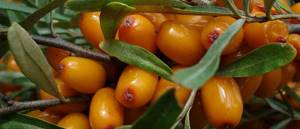
Excellent
Old (bred in the 1970s), honored variety of sea buckthorn. Fruit picking is facilitated by medium height, luxurious crown, absence of thorns, and “dry” separation. Good yield - up to 9 kg - has been pleasing for more than 10 years. Sweet and sour berries densely shower the branches. They are orange, slightly elongated, large (with an average weight of 0.7 g). The variety ripens by early September. With good resistance to cold and disease.
Sea buckthorn
There are wild fruit trees that are becoming cultivated varieties in our time. These species include sea buckthorn. Wild thickets of sea buckthorn in our country occupy an area of several hundred hectares, from which about 100 thousand tons of fruit are collected.
But, nevertheless, a number of research institutes are still engaged in a comprehensive study of wild forms of sea buckthorn. The most promising forms are selected from forest thickets, from which new varieties are developed.
In Siberia during Soviet times, several specialized sea buckthorn state farms were created. A research institution conducting work on the study, promotion and introduction of sea buckthorn into culture is actively working in Altai. Scientists from Siberia have identified 5 geographical forms of wild sea buckthorn: Daurian, Sayan, Chulyshman, Altai and Tien Shan.
The first valuable, large-fruited varieties were bred from the Siberian wildflower, such as: Golden Cob, Gift of Katun, News of Altai, etc. Sea buckthorn selection continues, an increasing number of scientific teams are involved in the study of the secrets of the Siberian pineapple. I didn't make a mistake.
This is exactly what we often call the fruits of sea buckthorn - Siberian pineapple, for their unique aroma, vaguely reminiscent of exotic pineapple. Modern selection is working on the size of sea buckthorn fruits and increasing productivity, breeding thornless forms and forms with a longer stalk.
Why has the Siberian pineapple become the object of such increased interest?
It turned out that sea buckthorn, as a fruit plant, successfully meets many of the requirements for modern fruit growing:
## It is precocious and does not grow tall; it begins to bear fruit already at 3-4 years of age.
## Sea buckthorn is very high-yielding; from cultivated plantings you can collect up to 2 tons of berries per hectare.
## Regularly, without intervals or rest, produces annual harvests.
## And what is the dignity of sea buckthorn fruits! And here are the healing properties of the plant
on high! Because sea buckthorn contains substances that simply cannot be found in other fruits! We are talking about the valuable properties of sea buckthorn oil, which is contained in the pulp of the fruit and has exceptional healing properties.
## Sea buckthorn is an excellent winter-hardy plant; even frosts of 50 degrees and evil dry winds are not a hindrance for it. It is cultivated even at 65 degrees north latitude, which is already very close to the Arctic Circle.
## Sea buckthorn does not need fertile lands; it easily takes root on poor soils of steep slopes, but feels better on sandy loam and sandy soils.
## And sea buckthorn has one more advantage: it has amazing immunity to pests and fungal diseases of fruit crops.
Russian academician Peter Simon Pallas once wrote that back in the 18th century, residents of Eastern Siberia used sea buckthorn as a valuable berry and medicinal plant.
Already at that time, we had in wide use jelly, jelly, jam and various drinks made from sea buckthorn fruits.
A decoction of berries, including, as we now know, the famous sea buckthorn oil, served as a constant and reliable medicine in the treatment of skin diseases, non-healing ulcers, rashes and even rheumatism.
And the seeds were used as a laxative. A potion with an astringent effect was also prepared from the fruits of sea buckthorn to treat dysentery.
And 70 years later, in 1850, Pallas wrote an article “Sea buckthorn berries and newly discovered sea buckthorn oil,” which attracted attention to this medicinal plant and they began to breed it. True, in culture it was initially used as an ornamental and soil-strengthening plant. It was only in 1930 that the chemical composition of sea buckthorn fruits was studied for the first time.
Where does the name sea buckthorn come from?
The name sea buckthorn was given by the ancient Greeks, which was retained by botanists. The name comes from the Greek - Hippophae: "hypos" - horse, "phae" - brilliant. The Greeks noticed that when horses and sheep ate young branches, fruits and leaves of sea buckthorn, their wool became glossy and shiny. The Russian name for sea buckthorn comes from the appearance of the branches, completely covered with small bright orange berries, under the weight of which the young branches droop down.
Description of sea buckthorn
Sea buckthorn, which grows everywhere in our country, belongs to the small Lokhov family - Elaeagnaceae, which includes only 3 genera and 45 species. In the wild, sea buckthorn is a prickly shrub, up to 3 meters high. Not long ago, gigantic forms of sea buckthorn were discovered in Azerbaijan and Kyrgyzstan, reaching up to 15 meters in height and a trunk thickness of up to 40 centimeters. Such a plant can hardly be called a shrub...
Leaves are linear-lanceolate from 3 to 8 centimeters. Above they are green or gray-green, and below, due to dense pubescence, they appear whitish-silver. Sea buckthorn is a dioecious plant: female specimens bloom and bear fruit, while male specimens bloom with small greenish-brown flowers and serve for pollination.
Therefore, when planting sea buckthorn, it is necessary to take into account that for about 5 female specimens, there should be one male specimen.
How does sea buckthorn reproduce?
The growth and reproduction energy of all sea buckthorn species is so high that it is sometimes called an aggressive breed. And for good reason, because a 5-year-old sea buckthorn bush has roots that go horizontally to the sides for 4-5 meters and can produce up to 20 offspring in this area, from which new trees grow. Each new tree produces offspring again.
In the wild, left to its own devices, sea buckthorn grows rapidly, occupying more and more new areas. In terms of the speed of growth and the capture of new territories, sea buckthorn ranks first among all trees and shrubs! It is also actively dispersed by birds, which eat its delicious fruits.
You can grow a new sea buckthorn plant by cutting a young shoot from a tree, sticking it into the soil, leaving 2 buds on the surface. The cutting quickly takes root and can be transplanted to a permanent place. Therefore, forest reclamation specialists consider sea buckthorn an ideal species for consolidating and landscaping loose sand in ravines, gullies, strengthening banks and railway embankments. Sea buckthorn tolerates soil salinity well. And in due time the soil becomes more fertile.
Siberian scientists have long struggled with the mystery of sea buckthorn nodules that completely cover its thin roots. More recently, scientists have discovered that the nodules on the roots of sea buckthorn are similar to the nodules of legume plants. These are peculiar nitrogen collectors; nitrogen accumulates in the nodules both from the soil and from the air. Thereby enriching the soil.
Large-fruited varieties
Varieties with fruits weighing 0.8+ grams are classified as large-fruited. They are the choice of gardeners who do not want to bother with “small things”. Such varietal species of sea buckthorn have been bred for all regions, including Siberia and the Moscow region.
Augustine
Sea buckthorn Augustine is endowed with the following advantages:
- not particularly spreading crown;
- very few thorns;
- large fruits (1.1 – 1.4 g);
- good yield - 16-18 kg per bush;
- resistance to frost, drought, fungus, pests.
Sea buckthorn diseases
Verticillium wilt
The most dangerous fungal disease of sea buckthorn. Distributed in all regions of its cultivation. Experts have established that the causative agent of the disease clogs the conducting system of sea buckthorn, and the plant dies. In affected plants, on individual or all branches, the leaves turn yellow and fall off in August, the fruits wrinkle, swellings appear on the bark and then crack. Plants die very quickly, literally the next year.
Control measures: Currently, this disease has no cure and no control measures have been found. Experts advise not to prepare cuttings for propagation from sea buckthorn with signs of disease, but to dig up the affected plants, burn them and not plant sea buckthorn in this place for several years.
Amateur gardeners have already appreciated sea buckthorn and gladly accepted it into cultivation. The shrub, little known in the recent past, has firmly become one of the best multivitamin plants.
High-yielding varieties
Breeders have developed varieties of sea buckthorn to suit all needs. If the number of berries is a priority, high-yielding varieties are planted. From each person they will take not 5-7 kg, but three or four times more. But sometimes you have to put up with thorns, too thick crown, and sourness of the fruit. But there are options for ripening periods.
Abundant
Late-ripening variety, shrubs not lower than average height, with a spreading spherical crown. Productivity – 15 kg, with good care + 45-50%. Fruits first appear on a 3-4 year old plant. Sea buckthorn has a dark orange color and a cylindrical shape. It is dense and does not crush when collected. Large, 0.85 - 0.9 grams, with delicate sourness. The variety is resistant to diseases, severe cold, heat, and drought. It is recommended to plant in sunny areas.
Botanical
Botanical amateur sea buckthorn is valued for its generosity (up to 20 kg of berries per bush) and low thorniness. The berries are yellow with an orangish tint, up to 0.85 g. The variety is intended for the northern regions, including the Moscow region. It is not afraid of cold weather or disease, but ripe fruits must be harvested immediately.
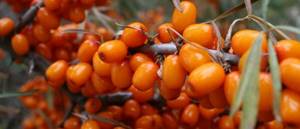
Chuyskaya
The main advantage of the variety is the almost complete absence of thorns. The usual harvest from a bush is 11.5-12 kg. A good harvest (22-23 kg) can be obtained if agricultural practices are followed. Sea buckthorn ripens by mid-August, becoming bright orange, weighing up to 1 g.
The bushes are low, with a spreading, but not particularly dense crown.
Panteleevskaya
The ripeness of sea buckthorn is indicated by the red-orange tint of the peel. The fruits resemble a flattened oval of medium size (maximum 0.75 g), 11-19 kg are gained from the bush. They are collected in the final ten days of September. They do not choke when collected, but are not suitable for long-term transportation. The shrub grows slowly and has almost no thorns. It tolerates severe frosts, diseases, and pest invasions without problems.
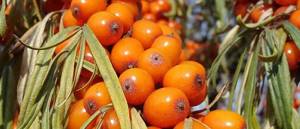
Gift to the garden
Small-thorned shrubs with an umbrella crown. The harvest is harvested by the end of summer, it is abundant - 20+ kg per bush. The rich orange berries are large, from 0.8 g. But sour, and even with a tartness and an astringent aftertaste. Suitable as a source of oil. The bushes are not afraid of cold weather. They are compact, which is appreciated by owners of small plots.
Gift from Moscow State University
Sea buckthorn Gift of Moscow State University is a spreading bush up to three meters high. In the description of the variety, universalism is often noted: the benefit is complemented by decorativeness.
Another plus is high yield (up to 20 kg per bush). It is easy to collect: the stalks come off effortlessly, dry. The harvest is suitable for transportation. The fruits ripen in summer, becoming bright orange. Quite large – up to 0.7 g. The abundance of vitamin C creates a slight sourness. Shrubs are resistant to natural disasters, pests, and diseases.
Sea buckthorn in my garden
4.7
(30)
Sea buckthorn in my garden
Hello readers of my garden blog!
Today I’m writing a note about the varietal sea buckthorn that grows in my garden. All the varieties I grow were purchased from the originator - the Lisavenko Research Institute in Barnaul. This institute has been engaged in sea buckthorn breeding for a very long time, practically a pioneer in our country (then the USSR) in this area.
In general, in the Altai Territory, sea buckthorn also grows in its wild form in some places along river floodplains. I know these places near the rivers Biya, Katun, Chemrovka. As a kid, I rode a moped (this was in the 80s and early 90s) to these hot spots and picked yellow and even orange berries with 50-liter bags. They were collected many times from the beginning of September until October, until the berries became unusable on the bushes after the hardening morning frosts.
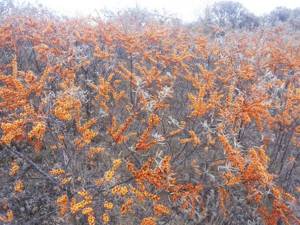
Sea buckthorn in late autumn
The wild bushes were abundantly covered with berries, but the berries were very sour - you could eat a handful and your teeth would set on edge, and the bushes themselves were very prickly. We traditionally tore it with wire scrapers - it was impossible to collect it by hand, because the wild berry has a “wet” tear. Well, at home they already sifted a 1*1 meter sieve on a sheet of paper, separating the marketable berries from the broken ones and from the foliage.
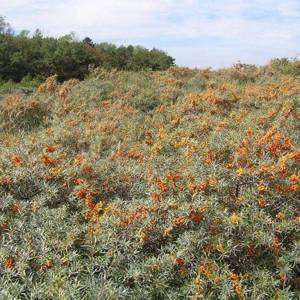
Thickets of wild sea buckthorn
Imagine my surprise when many years later, already in 2005, I first saw the cultivated varieties - Chuyskaya, Augustina and Essel . And I not only saw, but also tasted these wonderfully tasting berries - there is practically no acid in the taste, especially in the Augustina and Essel varieties. And how impressed I was by their size!
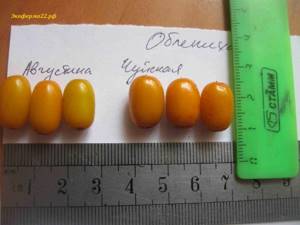
Elite sea buckthorn
Look at the photo - the berries are simply gigantic for this crop. Anyone who has seen the fruits of wild sea buckthorn with a berry less than the size of a pea will understand this!
The photo above was taken on August 23, by the beginning of September the berries became larger and sweeter. See photo below:

Large-fruited dessert varieties of sea buckthorn
I firmly decided that I would plant these varieties in my garden plot (I really love home-made sea buckthorn juice - it’s just a drink of the gods that you can’t buy anywhere for any money!). The drink recipe is at the end of this video (link to video below). You can also cook delicious jelly and probably other dishes.
In terms of yield - up to 20 kg per bush - the leader is the Chuyskaya variety, which has long been widespread in Siberia, and in terms of maximum weight (almost 1.5 g) - four new products of recent years - Afina (a more technical variety), Augustina, Essel and Azhurnaya, they are three times larger than the first varieties of the 1960s, and five times larger than the wild varieties! All the trees in the garden are short, and I can easily reach the very tops (this is a huge plus and a modern gardening trend!)
Today (2018) I met with a person who, for many years, has been breeding and testing new varieties of sea buckthorn at the Lisavenko Research Institute - Yu. A. Zubarev. I also asked him about varieties of sea buckthorn from other regions of Russia and even Scandinavian countries (for example, it grows in Norway) and he unequivocally stated that the best varieties are Altai and this is recognized by everyone who is familiar with this culture and even foreigners associate the Altai region with sea buckthorn!
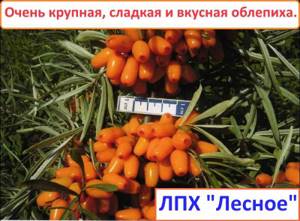
Elite sea buckthorn with giant fruits
By the way, sea buckthorn varieties bred at the Lisavenko Research Institute in Barnaul are massively purchased by foreigners for planting plantations - Greece, Bulgaria, the Czech Republic, China and others. And this says a lot, it confirms that Altai varieties of sea buckthorn are leaders. If anyone is interested, you can Google it.
There is such a PERSON - Elizaveta Ivanovna Panteleeva, perhaps the most authoritative sea buckthorn scientist, laureate of the USSR State Prize, winner of the Rudolf Hermann Honorary Prize (Germany), and most importantly, the author of four dozen varieties of sea buckthorn, which were created by her together with colleagues at the Lisavenko Research Institute almost for 60 years of breeding work.
In Siberia, wild sea buckthorn lives on the sandy banks of rivers and is considered one of the hardiest plants that can easily withstand severe frosts (for me it can withstand -49 degrees without loss). However, genetically it is adapted only to winters with little snow, deep freezing of the soil and stable temperatures without sharp fluctuations in the cold season. And only in the presence of all the listed factors can it maintain winter hardiness with prolonged deep sleep.
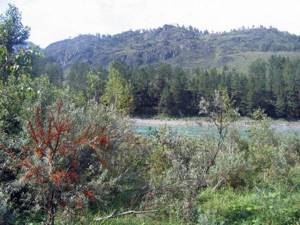
Wild sea buckthorn in the river floodplain
In “mild European winters”, by no means with little snow, as in the Trans-Urals, but most often with a thick white “blanket”, the resistance of this plant to sharp drops in temperature after prolonged thaws decreases.
Under the snow cover in the thawed soil, the “Siberian” awakens ahead of time, spending the entire supply of nutrients on breathing, and... suffocates from oxygen starvation and excess carbon dioxide. Often its bark and cambium at the root collar and on the lower part of the trunk are damped out. A weakened plant loses its immunity to fungal diseases - fusarium and verticillium, the pathogens of which always swarm in clayey, loamy and chernozem soils with a heavy mechanical composition, which are not at all typical for the habitat of wild sea buckthorn. Therefore, in the European part of Russia, there may be some problems with this crop that in its homeland - Western Siberia - they are not even aware of.
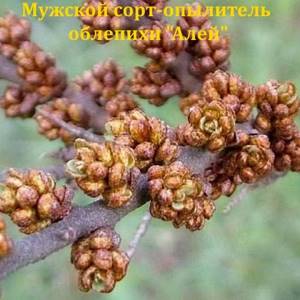
Unlike the European part of the country, in Eastern and Western Siberia, in particular in the Altai Territory and the Altai Mountains, sea buckthorn remains the most popular berry crop for two reasons. Firstly, thanks to the tradition of the local population to prepare juices, compotes and wines from this berry. Secondly, it provides the main raw materials for several industrial enterprises that produce oils, lotions, ointments and other natural-based medicines. Therefore, both small garden plots and huge gardens in Siberia in August-September are bursting with sea buckthorn abundance.
In addition to all kinds of vitamins, the berries of many modern varieties of sea buckthorn contain up to 7% valuable oil (it simply magically heals skin ulcers, burns and eczema - tested by more than one generation of Siberians), as well as a significant amount of vital minerals.
Judging by the latest research by biochemists, in particular JSC Altaivitamins in Biysk, biologically active substances are found not only in sea buckthorn berries, but also in the leaves and even in the bark. Among them are hydroxycoumarins, which prevent the formation of blood clots in blood vessels, and triterpene acids with cardiac effects, which increase blood circulation in the cardiovascular system, and in combination with betaine (of which there is also a lot here) reduce cholesterol levels in the blood.
Another substance rarely found in plants was found in sea buckthorn bark and leaves - serotonin, which has a positive effect on our emotions, mood, and promotes deep sleep. So everyone needs sea buckthorn.
Agricultural technology
- We plant 1 male (pollinator) tree on several female (berry) trees. The closer, the better for the harvest. For industrial plantings, the male pollinator variety “Aley” is recommended - a real giant. For private garden plots, the more compact variety (but also with excellent male qualities) “Gnome” is preferable. Both varieties can be purchased from us, at the Lesnoye private farm (website: Ekoferma22.rf).
- It is advisable to plant in light soil - a mixture of sand, compost or humus and earth. It is advisable to exclude clay. The root system of sea buckthorn is superficial, and to avoid future problems with breaking out the root system during strong winds, we deepen the root collar of the seedling by 10 cm). We plant not “firewood”, but 1-2 year old seedlings.
- I plant sea buckthorn (as a zoned winter-hardy plant) in the fall, until the end of September. So far there has been no loss of seedlings after wintering. Personally, in my gardening practice with this plant since 2007, I have only once encountered the drying out of a young sea buckthorn seedling in the summer. Another one was put in his place and the same problem did not happen again.
- Plant sea buckthorn in a bright place; when shaded and crowded, it bears fruit poorly and the berries become smaller. The seedlings are planted at a distance of 2-3 meters from each other, in one row, somewhere along the fence - this is more rational.
Important!!! Only seedlings obtained vegetatively (root shoots or rooted cuttings) can transmit the varietal properties of the mother tree. A seedling cannot be a variety.
We sell ONLY seedlings obtained by vegetative means (for the most part, we root green cuttings, since there is a limited amount of root shoots). That is, the grade of seedlings is maintained.
I recommend planting the following varieties (I don’t pretend to be the ultimate truth):
From dessert (you can eat fresh berries from the bush, minimum acidity and maximum sweetness, there is an individual bouquet in the taste): Augustina, Essel, Chuyskaya, Altai
Technical: Athena (newest variety), Elizaveta, Inya - these are large-fruited varieties with dry separation. A very productive variety, but the berries come off wet - the Obilnaya variety.
Much has already been written. Now just watch my short review video, in it I give a brief educational program and recommendations on the varieties that have passed through my hands, but this does not mean at all that there are no other worthy varieties. My review is my subjective view of a person who has seen a LOT of different things about this culture, but by no means everything!
By planting sea buckthorn in your garden, you take the ecology of your healthy diet to a new quality level! And you can’t buy this ANYWHERE and FOR ANY money.
I hope this note for you, my reader, was truly interesting and useful.
Siberian experienced gardener,
Ermakov Sergey
How helpful was this post?
Click on the icon to rate it! 5th icon on the far right (excellent rating).
average rating 4.7 / 5. vote count: 30
No votes yet! Be the first to rate this post.
Low-growing varieties of sea buckthorn
Sea buckthorn trees or bushes are not particularly tall. But harvesting is still difficult for many. Especially if the owner of the site is short or cannot use a stepladder, ladder, or other device. For them, breeders have created varieties of sea buckthorn no higher than 2.5 m - with different yields, quality of berries and ripening periods.
Amber
Amber sea buckthorn is an old, honored variety. For the berry, the description of the variety includes the following information: it looks like an orange cylinder weighing 0.65-0.75 g; ripens in early September.
Fruits abundantly and stably from the fourth season for 11-12 years. Peak harvests occur in the fifth or sixth years: 13.5-14.5 kg are harvested from a bush, compared to the usual 9-10 kg. Harvesting sea buckthorn is made easier by the almost complete absence of thorns.
Inya
The advantages of sea buckthorn Inya, mentioned when describing the variety, are a small number of thorns against the background of high yield (up to 14 kg) and large berries (up to 1 g), good winter hardiness. Sea buckthorn is easy to remove due to the low height and density of the bush. The variety is early ripening, the red-orange with a “blush” berries are tasty and aromatic.
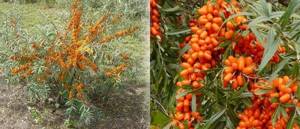
Thumbelina
The low (up to 1.5 m) compact crown makes the variety in demand by owners of small plots. Sea buckthorn has very few thorns. The harvest is good - 18-20 kg, ripening by the first half of August. The peel is thick orange, the fruits are tart, but large - 0.65-0.75 g. There is immunity against frost and pests.
Friendly
Miniature shrub of early maturation with a compact crown and low height. Harvesting is accelerated by crowding on the branch, dry detachment, size of the berries (up to 0.8 g) and the absence of thorns. Although the yield is average, 10-11 kg. The orange-red oval fruits exude a fresh aroma and a medium taste. Good resistance to disease and cold.
Moscow Beauty
For sea buckthorn Moscow Beauty, the description of the variety includes several advantages: low plant height, compact crown, minimum thorns. The fiery orange berries (0.6 g) are endowed with a sweet and sour taste and are torn off dry. Sea buckthorn is harvested in the second half of August, up to 15 kg per bush.
Subtleties of caring for sea buckthorn
During the period of active growth, sea buckthorn loves moderate fertilizing with phosphorus-potassium fertilizers. Do not overdo it with nitrogen and organic matter. It makes no sense to apply fertilizers to the tree trunks of an adult bush.
Throughout the growing season, sea buckthorn needs good watering, but stagnation of water should not be allowed.
Fruiting of sea buckthorn begins 3 - 4 years after planting the seedling. Until then, formative pruning is important to create the correct shape of the bush’s crown. It is carried out in early spring before the buds open, removing improperly growing young growth and diseased shoots. 8 - 10 years after planting, anti-aging pruning is carried out, leaving only 3-year-old shoots. Annual sanitary pruning helps clear the bush of dry, diseased and frozen shoots.
Sea buckthorn can be affected by diseases and pests. To combat them, it is better to start with biological and mechanical methods, since the use of chemicals will negatively affect the medicinal properties of the fruit.
Frost-resistant varieties
Sea buckthorn is the number one traditional supplier of vitamins for Siberia. But natural species do not always take root at other latitudes. Therefore, breeders have created varieties that are resistant to frosts of varying severity.
Jam
It combines thornlessness, large fruit (berry weight 0.85-0.9 g), resistance to frosts down to -36°C and drought. The bush is not tall and begins to bear fruit in the fourth year. The harvest ripens in early September; 9-12 kg are obtained from the bush. The berries are orange-red, elongated, with a dessert taste. Cons: does not tolerate heavy and acidic soils, vulnerable to sea buckthorn fly.
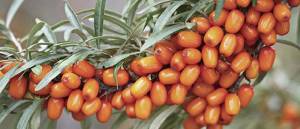
golden cob
A bush of medium height with a compact crown, almost without thorns. Produces 14-27 kg of harvest, which ripens in late summer. The berries are small (0.55-0.6 g), but decorative. They are bright blush-orange balls. In the description of the sea buckthorn variety Golden Cob, it is indicated that the fruits are suitable for obtaining oil and other technical purposes.
Trofimovskaya
Tall compact shrub with an umbrella crown and moderate thorniness. Fruiting starts from the 4th-5th season, bringing 8-10 kg per bush. Sea buckthorn matures by the first days of September. It is red-orange, 0.65-0.75 g each. It is distinguished by a thick, slightly pubescent skin.
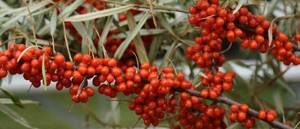
Pepper
Sea buckthorn variety Perchik is a shrub that has “average” characteristics: height, number of spines, dimensions of the crown and berries, ripening time.
The bush produces 8-13 kg of berries, which, when ripe, become orange-glossy and scaly. Sourish, but aromatic, suitable for technical purposes.
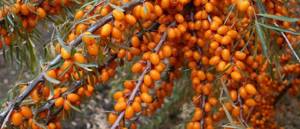
Ayula
The main advantages of the variety are the absence of thorns and good yield. A medium-height shrub with a spreading oval crown is resistant to frost, drought, and sea buckthorn fly. Yields 14-20 kg of sea buckthorn. It is large - 0.7-0.8 g, ripens in the first ten days of September. It has a dark orange “ruddy” skin and a pleasant taste with a bit of sourness.
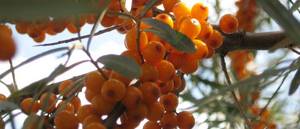
Otradnaya
Pyramidal powerful thorny shrub. Withstands severe frosts. Produces 12-13 kg of red-orange berries. They are sour and emit a subtle aroma. Covered with a glossy, loose skin.
Section materials
February 25, 13:26
The geography of the XXII Russian-Finnish Cultural Forum will be expanded
05 February, 10:24
Mikhail Piotrovsky took part in a discussion about the “Beyoncé effect”
January 22, 11:43
Russian-Finnish Cultural Forum is looking for partners
December 14, 12:27
A forum on the topic of the Nazi genocide of the peoples of the USSR was held in St. Petersburg
December 10, 11:09
Forum “The Arctic: Present and Future” will be held in St. Petersburg
Male varieties of sea buckthorn
Pollination is required for fruit to set. But in nature, sea buckthorn does not self-pollinate; this function is assigned to “male” trees or shrubs. They do not bear fruit, but their flowers provide pollen to the female plants, which is carried by the wind.
Work is underway to create self-fertile varieties of sea buckthorn.
In nature, the resources of a “male” bush are enough to fertilize 6-8 “female” ones. Breeders have bred specimens of greater productivity: one tree for 11-19 “female” trees.
Dwarf
When describing the sea buckthorn variety Gnome, they primarily emphasize “pollen productivity.” The plant is endowed with immunity to diseases and winter hardiness. The bush is compact, no higher than 2.5 m. A good option for small areas or commercial plantings.
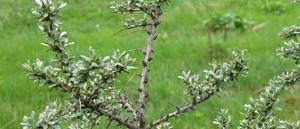
Aley
Sea buckthorn variety Alei is one of the most productive. 95-96% of pollen is “fertile”. This is natural, since breeders have instilled good immunity to diseases, pests and natural disasters.
Sea buckthorn propagation
There are various ways to propagate sea buckthorn. Among them, they are distinguished by seeds, layering, dividing the bush, shoots, and cuttings. The most appropriate and relevant of them is the last one.
Propagation by cuttings
Peas Gloriosa - growing peas at home
This type is the most common, as it allows you to quickly get results similar to those in the nursery. Woody cuttings are branches of a plant that have gone dormant and are cut off. They are usually prepared in November. The thickness of the branch should not be more than 5 mm. They are placed in a cool place and stored until spring.
In spring they are placed in water for 2-3 days. After this, they are placed in a solution that allows roots to form. When the roots appear, you can start planting. The soil temperature should be from 10 °C at a depth of 10 cm. The soil should be light, it is advisable to prepare it in the fall.
Note! If the soil is heavy, then sand is introduced into it.
Rooted cuttings are planted, leaving 1-2 buds above the ground, then mulched and watered.
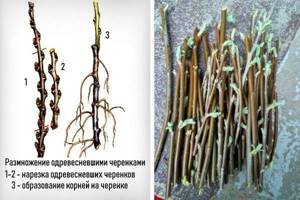
Breeding sea buckthorn by cuttings
Orange sea buckthorn
Bright orange is the classic color of sea buckthorn. Specimens with fruits of this color have been bred for different regions, including Siberia and the Moscow region.
Ayaganga
This species has compact, medium-tall bushes with a moderately dense, rounded crown. They produce 8.5-11.5 kg of berries heavier than half a gram. They are tasty and shaped like barrels. They reach maturity by the second ten days of September. Very good resistance to cold, average to dryness.
Sayana
Compact, not very tall shrub with few thorns. It bears fruit from the third season, producing 11-16 kg of berries annually. Ripens in early summer. The berries are medium-sized, slightly sour. The orangeness of the thick peel is diluted by red “spouts”.
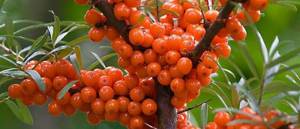
Lights of the Yenisei
The bush is tall, luxurious, but not particularly generous - 8-9 kg. The berries are medium in size (0.6 g), sweet and sour, with a fresh aroma. Harvesting is facilitated by minimal thorniness: the thorns are short, there are few of them and only in the lower segment of the shoots. This is an early ripening sea buckthorn, with immunity to disease, drought, and frost.
Red-fruited sea buckthorn
A bush with scarlet berries is probably the most elegant and decorative on the site. Such specimens are planted not only for benefit. They are pleasing to the eye, enriching the color scheme of the garden.
Rowan
Shrubs with a pyramidal crown. There are few thorns, which makes harvesting easier. It is not rich - 5.5-6 kg, there is a hint of bitterness in the taste, although the aroma is impeccable. The fruits are purplish-red glossy. This is a mid-season variety, resistant to fungus and other diseases.
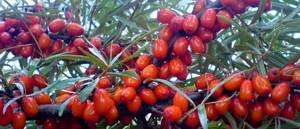
Siberian blush
A bush with a narrow pyramidal crown and few thorns. Yields 5-6 kg of sea buckthorn. The shiny burgundy fruits are aromatic, but slightly bitter. The variety is mid-season, with good immunity to mycoses.
Red-fruited
A powerful spreading plant with a pyramidal crown. There are a few berries - 5-6 kg. They are aromatic, but sour, not the most tasty, medium in size (0.6 g). They go for technical purposes. They ripen early and are moderately resistant to frost. Harvesting sea buckthorn is complicated by the total thorniness throughout the entire branch.
Red torch
A bush of medium height with a moderately spreading crown. There are few thorns. Produces 5.5-6 kg of berries per season. They are red with an orangish tint, large (up to 0.75 g). It ripens late, but is resistant to frost (down to -40°C), pests, and diseases.
Lemon green sea buckthorn
A bush with berries resembling microscopic lemons or limes is a curiosity of the sea buckthorn family. Such sea buckthorn is worth planting if only for the sake of adding exoticism to a classic garden.
Herringbone
Sea buckthorn self-fertile Herringbone lives up to its name. She looks like a fluffy Christmas tree. The height is good - from one and a half to two meters. The plant is compact and does not require much space on the site. Another plus is the absence of thorns.
However, gardeners need to realize that this is not the final “edition” of the variety; testing continues. But the plant can change. The only thing that remains unchanged is its resistance to cold and fungus.
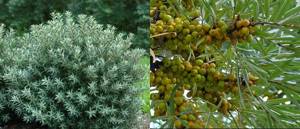
Early ripening varieties
For people who want to enjoy the harvest early, early ripening varieties have been created. Sea buckthorn is rich in vitamin C and ripens towards the border between July and August, at the latest at the end of the first ten days of August.
Cons
The plant is three meters high with a spreading crown of medium density. Harvest - 15-24 kg of fruit. The collection is facilitated by the complete absence of thorns. The fruits are large (0.7 g), sweet and sour, and look like yellow-orange cones. Good resistance to severe cold and fusarium.
Botanical amateur
Sea buckthorn Botanical amateur is an early ripening shrub up to 4 meters with a pyramidal crown and few thorns. Gives 7.5 - 14.5 kg of berries. They are large (up to 0.85 g), elongated oval, orange-yellow in color.
They are resistant to cold and disease, but the harvest is harvested immediately: it instantly becomes overripe, which affects transportation. The variety was bred for the northern regions, including the Moscow region. Botanical aromatic sea buckthorn also belongs to high-yielding varieties. It has the same coloring, but with a red spot on the top. The yield is good, up to 15 kg per bush. The berries are smaller and can be transported without problems.
Types and varieties
What does sea buckthorn look like? Science has established 2 types of sea buckthorn. This:
- the aforementioned sea buckthorn. It grows on the territory of the European continent and has the medicinal properties of sea buckthorn;
- sea buckthorn. It grows in the Republic of Nepal, the Kingdom of Bhutan, in the mountainous regions of the Republic of India, in the southern part of the Xinjiang Autonomous Region of China, where sea buckthorn retains its beneficial properties and contraindications.
Question: Is sea buckthorn a tree or a shrub? The answer depends on the type of sea buckthorn.
Below are only the best varieties of this plant and pictures.
Early varieties
The most productive ones are:
- Golden cascade. Demonstrates resistance to pests and resists diseases well and the beneficial properties of sea buckthorn for the human body.
- Openwork. It is characterized by frost resistance and increased drought resistance. Tolerates heat well;
- Inya. Frost-resistant low bush. It has a sparse but spreading crown;
- Red sea buckthorn. It is also called red-fruited because of the color of its berries. Red sea buckthorn is a vigorous variety with a spreading crown. The level of cold resistance is average. Demonstrates disease resistance. Sea buckthorn contains beneficial properties and contraindications for women;
- Pearl oyster. It is an extremely early variety. Characterized by frost resistance. However, sea buckthorn of the pearl mussel variety does not tolerate very high temperatures and lack of moisture, but there are benefits of sea buckthorn for the woman’s body;
Medium-ripening varieties
These include:
- Pepper. It differs in that its crown is umbrella-shaped. In addition, its sour, oval, orange-colored berries are characterized by the aroma of pineapple, which includes the beneficial properties of the berries;
- Botanical. A brief description of the Botanical sea buckthorn variety is formulated as follows: resistant to frost, successfully resists pests, sea buckthorn has beneficial properties and contraindications for men;
- Chanterelle. This is a low-growing bush with a not very spreading crown. Tolerates severe frosts well. Immune to diseases and pests;
- Darling. This variety has a peculiarity: the plant can be a thorny bush or a medium-sized tree. But in any case, such an individual is characterized by increased frost resistance and the benefits of sea buckthorn for the human body;
- Glow. Also a frost-resistant variety. It is practically not affected by diseases and successfully copes with pests. The sour berries have a characteristic orange-crimson hue, which is why sea buckthorn is beneficial for a woman’s body;
Late varieties
The most popular include:
- Giant. There are no thorns on the branches of this tree. Large egg-shaped berries have an excellent, rich taste and beneficial properties of the berries;
- Herringbone. This variety got its name due to the fact that its cone-shaped, narrow crown resembles a young spruce. The lemon green berries have a rather sour taste;
- Zlata. Gives a consistently high yield of round-ovoid berries with a color approaching straw and with a characteristic sourness, which gives the beneficial properties of sea buckthorn;
- Chuyskaya. This variety tolerates winter cold. However, fungal infections cause significant harm to it.
- Elizabeth. On low bushes a miniature crown is formed. In terms of yield, it is perhaps the best variety of Russian selection, which is why sea buckthorn is beneficial for the human body.
Mid-season varieties
These types of sea buckthorn mature by the second half of August or the first ten days of September. Almost all are large, sweet, with good transportability.
Chanterelle
A low shrub with a moderately spreading crown. The yield is good - 16-21 kg per bush. The berries are large (up to 0.8 g), resembling reddish-orange cylinders. Very tasty, with a high content of vitamin C, but sweet and aromatic. The thick peel extends the shelf life of sea buckthorn after harvest.
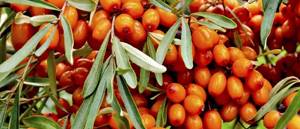
Bead
Tall spreading shrub with short thorns. Produces 13.5-15 kg of sea buckthorn per year. The dense orange fruits, weighing half a gram, look like a truncated cone. The sweet and sour taste is complemented by a fresh aroma. Good drought resistance.
Nivelena
Nivelen's sea buckthorn is described as a variety that is not particularly productive, but is winter-hardy. Suitable for Siberia and latitude regions near Moscow. These are shrubs of medium height and dense umbrella crown. Each produces up to 10 kg of berries. There are few thorns, they are thin. The fruits are yellow-orange, 0.5 g each. Sour, aromatic, with good transportability.
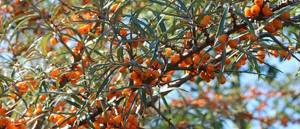
Bonfire
A bush of medium height with a moderately spreading crown. Remove 7-8 kg of sea buckthorn. It is crimson-orange, slightly elongated. Endowed with refreshing, sweet and sour pulp. Standard fruit weight is 0.75-0.9 g. Good frost resistance.
Late ripening varieties
Sea buckthorn of this segment is recognized by its resistance to frost and bright orange berries that ripen by winter. They taste better after the first frost.
Ryzhik
Shrubs of lower than average height with a moderately spreading crown and smooth shoots. The yield is good - 12.5-14 kg of sea buckthorn per bush. The berries are purplish-red and look like pointed cylinders. Sourish, but large, 0.7-0.8 g each. Thanks to the thick peel, they do not deform during transportation. Universal to use.
Orange
A bush of medium height with an oval crown and a minimum of thorns. Productivity 15 - 25 kg. The berries are orange-red, elongated, sour with astringency. They tear off dry and do not wrinkle during collection and transportation. Useful due to excess vitamin C. Winter hardiness is good, but the plant dries out due to mycosis.
Zyryanka
Bush 2.3-2.6 m high with an oval crown and sparse thorns. The harvest is good, 12-14 kg per season. Sea buckthorn is sour, but large (0.65 - 0.75 g). It looks like light orange cones with red spots.
They are not deformed during collection and transportation. “Indifferent” to fusarium.
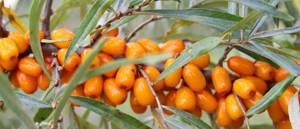
Baltic surprise
A bush under three meters with a luxurious crown and few thorns. 7.5 - 8.5 kg of red-orange berries ripen on it. They are no larger than 0.4 g, moderately sour, aromatic.
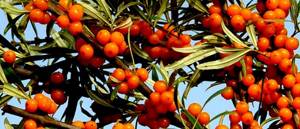
Amber necklace
These light orange berries resemble amber beads. Each weighs more than a gram. Although sea buckthorn bushes are not tall, each yields 12-14 kg. Good winter hardiness, almost universal immunity to disease.
Mendeleevskaya
A shrub no taller than two meters with a luxurious crown. Gives 7-8 kg of berries. They have an oval shape, a rich yellow peel color and a good weight - 0.50 - 0.65 g. Another plus is that sea buckthorn is rich in ascorbic acid.
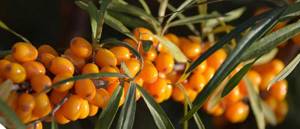
Yakhontovaya
Late ripening sea buckthorn variety from new ones. Shrubs of medium height with a moderately spreading crown and a small number of thorns. 9.6 - 10.7 kg of sweet and sour fruits are collected from the bush. They are large (0.85 g), slightly elongated. The peel is thin but dense, light red with mottling. Good resistance to frost, dry winds, and diseases.
Galerite
A variety that ripens by mid-September. A shrub no taller than two meters, with a spreading crown. An adult plant produces a maximum of 10 kg of sea buckthorn. It is large - 0.85 - 0.95 g, light orange with a reddish spot on the top. The sour and bitter pulp is wrapped in a thick, glossy peel.
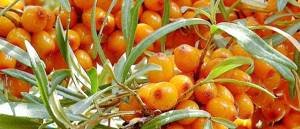
Lady fingers
Another newcomer to the sea buckthorn family undergoing testing. The name is given by the cylindrical shape of the berries. It is a bush of medium height with a compact crown. Gives up to 6 kg. The berries are bright orange, 1.1-1.3 g each. They are endowed with a dessert sweet and sour taste.
